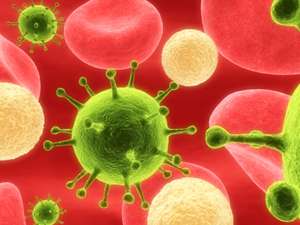Your basket is currently empty!
Sending in Trained
Sending in Trained Killers to Attack Residual HIV Infection
Adoptive transfer of epitope-specific CD8+ T cells augments immunity in HIV patients.
Chapuis, A., et al. (2011). HIV-specific CD8+ T cells from HIV+ individuals receiving HAART can be expanded ex vivo to augment systemic and mucosal immunity in vivo. Blood. 117:5391-402. [PMID: 21422474]
| Highly active anti-retroviral therapy (HAART) is given to HIV+ patients to suppress replication of the HIV virus and hold disease progression at bay. However, virus persists even with the treatment, residing mainly in gut-associated lymphoid tissues (GALT). HAART depletes CD8+ T cells, but at higher numbers HIV-specific CD8+ T cells could potentially work to eradicate the remainder of the viral reservoir, leaving the patient disease-free. Ideally, therapeutic vaccination with a peptide antigen would be used to provoke CD8+ T cell expansion, but a useful protocol has not yet been found, so researchers are looking at ex vivo expansion of a patient’s cells. |  |
Aude Chapuis and colleagues in the lab of Philip Greenberg at the Fred Hutchinson Cancer Research Center, sought to investigate the HIV-specific CD8+ T cells remaining in patients undergoing HAART, to look at their potential to persist if expanded ex vivoand returned to patients. To do this, they needed a reliable means of identifying disease-specific cells, and they chose ProImmune’s range of Pro5® MHC class I Pentamers.
Using Pro5® Pentamers to screen for epitope specificity, the team established a panel of CD8+ T cell lines from patient PBMC. These lines were specific for a range of HIV epitopes [B*08:01/GEIYKRWII (HIV-gag), B*07:02/IPRRIRQGL (HIV-Env), A*03:01/QVPLRPMTYK (HIV-NEF, and B*27:05/KRWIILGLNK (HIV-gag)]. The researchers were interested in working with lines that contained a high fraction of T central memory (Tcm)-phenotype cells. These cells are typified by expression of CD28, and studies of other viral infections have shown that Tcm are useful in an anti-viral response, being able to proliferate and produce IL-2 upon antigen re-encounter.
Their treatment protocol took the form of infusing patients with 3.3×109 cells of a cell line derived from their own PBMC, twice, with a 28-day gap. The persistence of transferred epitope-specific CD8+ cells was monitored by Pentamer staining of patient blood samples. The high sensitivity of Pentamer staining was essential for the protocol, as Chapuis et al. deemed ‘persistence’ to be >0.1% of circulating CD8+ T cells. Of the seven patients who took part in the trial, three achieved robust persistence of transferred cells after 100 days, while varying levels of success were seen for the therapy in the other four patients. T cells from the patients whose cell lines persisted all showed an increase in CD28 expression during the monitoring period, which strongly suggested that the cell lines used were derived from CD8+ Tcm. Unlike the rest of the transferred cells, CD28+ cells secreted IL-2 in response to antigenic challenge.
Next, the team analyzed the proliferation of antigen-specific cells from PBMC collected after T cell transfer. They used Pentamer staining in conjunction with CFSE dye dilution assay to show that CD28+ transferred cells could proliferate without exogenous cytokines, underscoring the importance of a Tcm phenotype for successful adoptive transfer. This is shown in figure 5 of the final manuscript.
Finally, rectal biopsy was used to confirm that transferred cells from all seven patients had trafficked to the GALT, and so would be able to provide a specific targeted immune response against the pool of persisting virus. A next step for the team is to establish a model in which this response can be visualized and measured.
This work relied on the ability to detect and track epitope-specific CD8+ T cells, for which ProImmune’s Pentamers were invaluable. Using these reagents, the study has successfully defined the cell types which are most useful in adoptive transfer as an antiviral therapy, which is a big step forward in HIV research.
